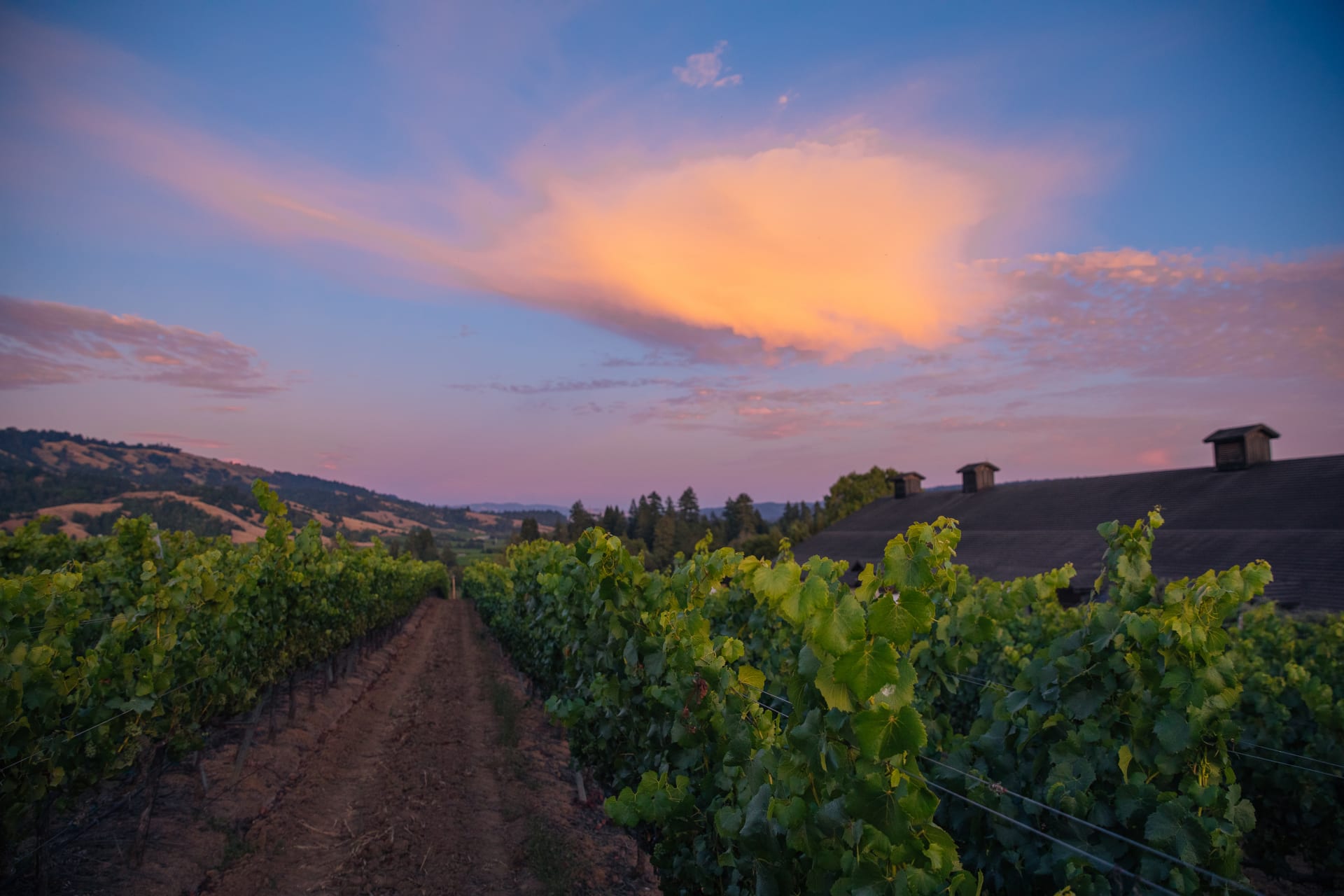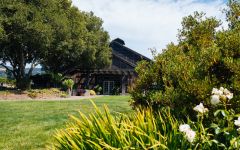Roederer Estate Brut Rose (1.5 Liter Magnum)
- Decanter
-
Robert
Parker -
James
Suckling -
Wine
Spectator -
Wine
Enthusiast -
Wine &
Spirits -
Connoisseurs'
Guide




Product Details
Your Rating
Somm Note
Winemaker Notes
The Roederer Estate Rose is full and round with smooth flavors and a fine, persistent mousse. The extra measure of Chardonnay contributes elegance and austerity that balance nicely with the delicate fruitiness of the Pinot Noir.
Professional Ratings
-
Decanter
This wine exudes class. It displays a wonderful pale pink colour with apricot and copper hue as well as tiny persistent bubbles. Aromas are delicate and refined including a combination of fresh berry fruits, toast, wild flowers and yeasty notes. On the palate it has wonderful creamy texture (two years on the lees have certainly contributed to the textural softness), attractive savoury complexity and a wonderful refreshing finish.
-
Robert Parker's Wine Advocate
The current release of the NV Brut Rosé is made up mainly of fruit from the 2015 vintage and is a blend of 55% Pinot Noir and 45% Chardonnay. It was made with about nine grams per liter dosage and was disgorged in March of 2019. Pale salmon-pink in color, it has a lively nose of red berries, crushed stone, musk melon, floral hints and citrus peel and a bright and fresh palate with loads of perfumed red berries and energetic mousse, finishing long and uplifted.
-
James Suckling
Strawberry with hints of white peach and some bread dough. Perfumed. Hints of cotton candy. Medium body. Fine bubbles. Flavorful finish. Reserved at the end giving it focus. A blend of 56% pinot noir and 44% chardonnay. 2019 base. Three years on yeast. 8.5g/L dosage.
-
Wine Spectator
Brisk and festive, this is simply fun to sip. Sleek and graceful, unfurling with an array of strawberry, orange zest and brioche flavors that finish with a refreshing lift. Drink now.
-
Wine Enthusiast
An aroma like prosciutto and dried figs and lively flavors of raspberry and tangy apricot bring a big personality to this crisp, well-balanced and complex wine.
-
Wine & Spirits
There’s ample red-apple flavor at the center of this wine, lingering with a light touch, and hints of spicy orange and ripe peach. That sweet fruit finishes clean, with a gentle sweep of acidity, balanced and long. For scallop sashimi.
-
Connoisseurs' Guide
56% Pinot Noir; 44% Chardonnay. Another in a long string of Brut Rosé successes from Roederer Estate, the winery’s latest is a rich and insistently foamy effort that displays subtle highlights of minerals and a nice bit of creamy complexity born of its time on the yeast. Its central and sustained message, however, is that of lightly juicy, cherry-like fruit, and, while fruity, it is wholly free of candied confection. A most enjoyable sipper on its own, it has the depth and the balance to match up famously with lighter salmon recipes or the sweet, first-of-the-season, local Dungeness crab just now coming to market.






Founded in 1982, Roederer Estate is nestled in Mendocino County’s fog-shrouded, Anderson Valley. As the California property of Champagne Louis Roederer, Roederer Estate builds upon a centuries-old tradition of fine winemaking. Roederer's unique winemaking style is based on two elements: complete ownership of its vineyards and the addition of oak-aged reserve wines to each year's blend or cuvee to create complex, dry and harmonious sparkling wines.
The crisp, fresh and rich flavors of Roederer Estate sparkling wines reflect the cool Anderson Valley that is home to their family-owned estate's 600 acres of vineyards. This protected valley in Northern California provides the ideal ripening conditions for their 100% estate-grown Pinot Noir and Chardonnay grapes. The blending team is comprised of the winemakers from the California property as well as from Champagne Louis Roederer, ensuring that Roederer Estate remains the most French of the California sparklers.

What are the different types of sparkling rosé wine?
Rosé sparkling wines like Champagne, Prosecco, Cava, and others make a fun and festive alternative to regular bubbles—but don’t snub these as not as important as their clear counterparts. Rosé Champagnes (i.e., those coming from the Champagne region of France) are made in the same basic way as regular Champagne, from the same grapes and the same region. Most other regions where sparkling wine is produced, and where red grape varieties also grow, also make a rosé version.
How is sparkling rosé wine made?
There are two main methods to make rosé sparkling wine. Typically, either white wine is blended with red wine to make a rosé base wine, or only red grapes are used but spend a short period of time on their skins (maceration) to make rosé colored juice before pressing and fermentation. In either case the base wine goes through a second fermentation (the one that makes the bubbles) through any of the various sparkling wine making methods.
What gives rosé Champagne and sparkling wine their color and bubbles?
The bubbles in sparkling wine are formed when the base wine undergoes a secondary fermentation, which traps carbon dioxide inside the bottle or fermentation vessel. During this stage, the yeast cells can absorb some of the wine’s color but for the most part, the pink hue remains.
How do you serve rosé sparkling wine?
Treat rosé sparkling wine as you would treat any Champagne, Prosecco, Cava, and other sparkling wine of comparable quality. For storing in any long-term sense, these should be kept at cellar temperature, about 55F. For serving, cool to about 40F to 50F. As for drinking, the best glasses have a stem and a flute or tulip shape to allow the bead (bubbles) and beautiful rosé hue to show.
How long do rosé Champagne and sparkling wine last?
Most rosé versions of Prosecco, Champagne, Cava or others around the “$20 and under” price point are intended for early consumption. Those made using the traditional method with extended cellar time before release (e.g., Champagne or Crémant) can typically improve with age. If you are unsure, definitely consult a wine professional for guidance.

Surrounded by redwood forests and often blanketed in chilly, ocean fog, the Anderson Valley is one of California’s most picturesque appellations. During the growing season, moist, cool, late afternoon air flows in from the Pacific Ocean along the Navarro River and over the valley's golden, oak-studded hills. High and low temperatures can vary as much as 40 or 50 degrees within a single day, allowing for slow and gentle ripening of grapes, which will in turn create elegantly balanced wines.
The Anderson Valley is best known for Pinot Noir made in a range of styles from delicate and floral to powerful and concentrated. Chardonnay also shines here, and both varieties are often utilized for the production of some of California’s best traditional method sparkling wines. The region also draws inspiration from Alsace and produces excellent Riesling, Gewürztraminer, Pinot Blanc and Pinot Gris.
